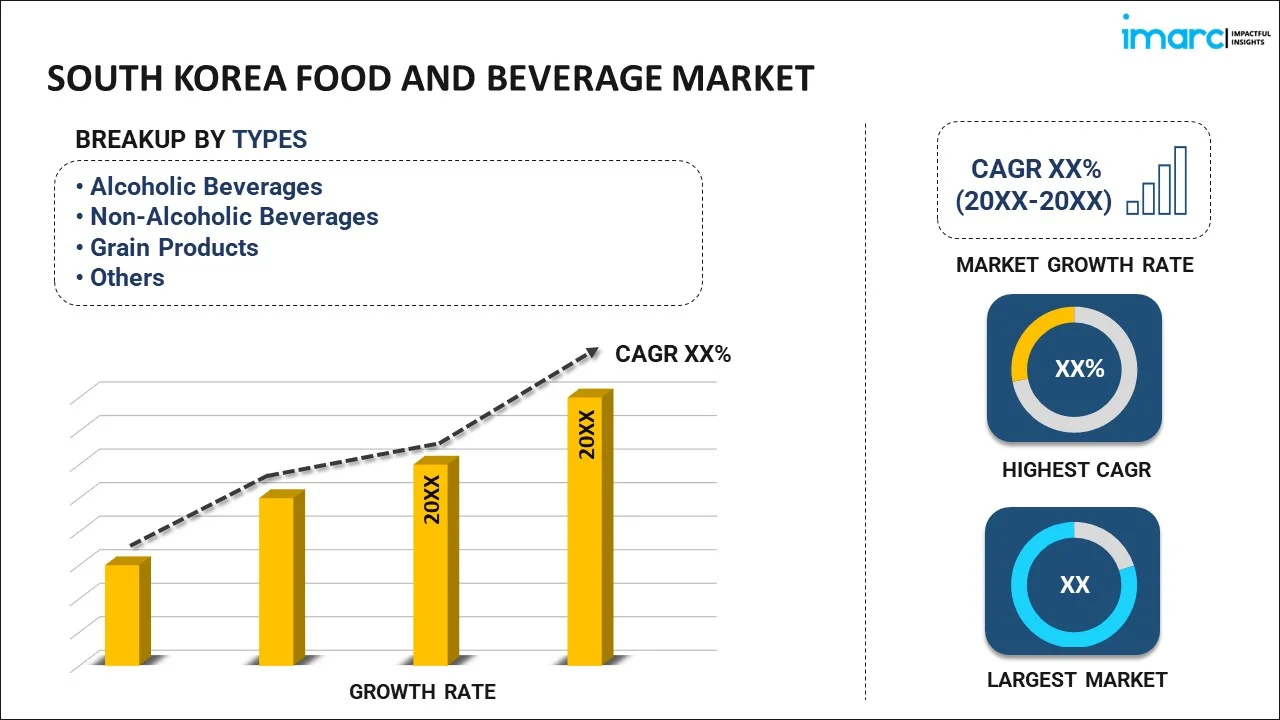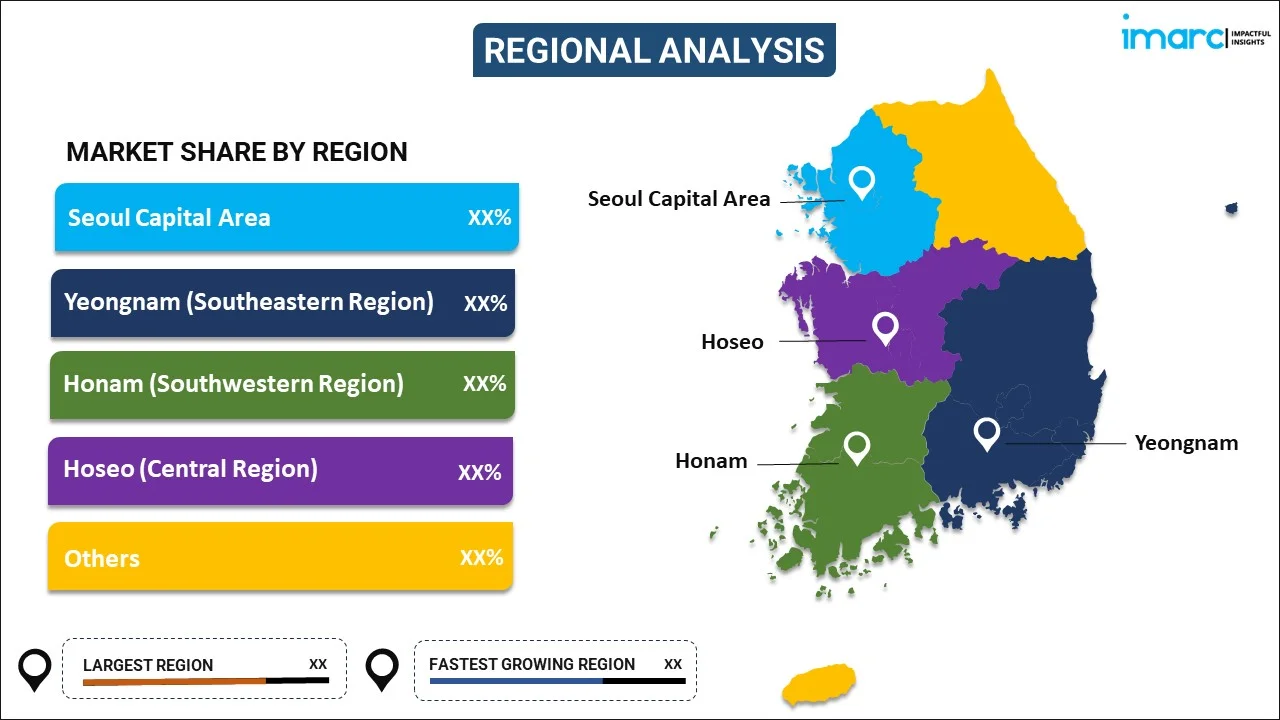
South Korea Food and Beverage Market Report by Type (Alcoholic Beverages, Non-Alcoholic Beverages, Grain Products, Bakery and Confectionery, Frozen, and Others), Nature (Organic, Conventional), Distribution Channel (Supermarkets and Hypermarkets, Convenience Stores, E-Commerce, and Others), and Region 2025-2033
Market Overview:
South Korea food and beverage market size reached USD 201.8 Billion in 2024. Looking forward, IMARC Group expects the market to reach USD 397.3 Billion by 2033, exhibiting a growth rate (CAGR) of 7.39% during 2025-2033. The market is driven by evolving consumer preferences, including increasing health consciousness, convenience food trends, and cultural exchange, alongside technological advancements, regulatory changes, and the rise of e-commerce.
|
Report Attribute
|
Key Statistics
|
|---|---|
|
Base Year
|
2024 |
|
Forecast Years
|
2025-2033 |
|
Historical Years
|
2019-2024
|
| Market Size in 2024 | USD 201.8 Billion |
| Market Forecast in 2033 | USD 397.3 Billion |
| Market Growth Rate (2025-2033) | 7.39% |
Food and beverage (F&B) refers to the industry encompassing the preparation, serving, and consumption of food and drinks. It spans a wide range of establishments, including restaurants, cafes, bars, food trucks, catering services, and more. The F&B sector is characterized by its focus on providing quality culinary experiences, diverse menus, and excellent customer service. It involves various aspects such as menu planning, sourcing ingredients, food preparation, presentation, and maintaining hygiene standards. Within the industry, trends like farm-to-table dining, fusion cuisine, and sustainable practices have gained prominence in recent years. Additionally, the F&B industry is heavily influenced by cultural preferences, regional specialties, and culinary innovations. From casual dining to fine dining establishments, the F&B sector plays a significant role in shaping social interactions, cultural experiences, and the overall hospitality landscape. Moreover, it serves as a dynamic sector with ample opportunities for culinary professionals, entrepreneurs, and enthusiasts to explore and innovate within a constantly evolving market.
South Korea Food and Beverage Market Trends:
The food and beverage market in South Korea is propelled by a multitude of interconnected drivers, each influencing the industry's growth trajectory. Consumer preferences play a pivotal role, as changing lifestyles and dietary habits shape demand patterns. Moreover, increasing health consciousness among consumers has driven a surge in demand for organic, natural, and healthier food options. Furthermore, cultural exchange has fostered an environment where diverse cuisines and flavors are embraced, driving innovation and variety in the market. Technological advancements have also revolutionized the industry, facilitating efficient production processes, supply chain management, and distribution networks. Additionally, the rising trend of convenience foods, coupled with busy lifestyles, has fueled demand for ready-to-eat meals, snacks, and on-the-go beverages. Furthermore, regulatory changes and governmental policies regarding food safety, labeling, and sustainability have significantly impacted industry practices and consumer behavior. Moreover, accelerated trends like e-commerce, home cooking, and health-focused products are also reshaping market dynamics. In essence, the food and beverage market in South Korea is a complex ecosystem influenced by a confluence of factors, constantly evolving to meet the diverse needs and preferences of consumers.
South Korea Food and Beverage Market Segmentation:
IMARC Group provides an analysis of the key trends in each segment of the market, along with forecasts at the country level for 2025-2033. Our report has categorized the market based on type, nature, and distribution channel.
Type Insights:

- Alcoholic Beverages
- Non-Alcoholic Beverages
- Grain Products
- Bakery and Confectionery
- Frozen
- Others
The report has provided a detailed breakup and analysis of the market based on the type. This includes alcoholic beverages, non-alcoholic beverages, grain products, bakery and confectionery, frozen, and others.
Nature Insights:
- Organic
- Convention
A detailed breakup and analysis of the market based on the nature have also been provided in the report. This includes organic and conventional.
Distribution Channel Insights:
- Supermarkets and Hypermarkets
- Convenience Stores
- E-Commerce
- Others
The report has provided a detailed breakup and analysis of the market based on the distribution channel. This includes supermarkets and hypermarkets, convenience stores, e-commerce, and others.
Regional Insights:

- Seoul Capital Area
- Yeongnam (Southeastern Region)
- Honam (Southwestern Region)
- Hoseo (Central Region)
- Others
The report has also provided a comprehensive analysis of all the major regional markets, which include Seoul Capital Area, Yeongnam (Southeastern Region), Honam (Southwestern Region), Hoseo (Central Region), and Others.
Competitive Landscape:
The market research report has also provided a comprehensive analysis of the competitive landscape in the market. Competitive analysis such as market structure, key player positioning, top winning strategies, competitive dashboard, and company evaluation quadrant has been covered in the report. Also, detailed profiles of all major companies have been provided.
South Korea Food and Beverage Market Report Coverage:
| Report Features | Details |
|---|---|
| Base Year of the Analysis | 2024 |
| Historical Period | 2019-2024 |
| Forecast Period | 2025-2033 |
| Units | Billion USD |
| Scope of the Report | Exploration of Historical Trends and Market Outlook, Industry Catalysts and Challenges, Segment-Wise Historical and Future Market Assessment:
|
| Types Covered | Alcoholic Beverages, Non-Alcoholic Beverages, Grain Products, Bakery and Confectionery, Frozen, Others |
| Natures Covered | Organic, Conventional |
| Distribution Channels Covered | Supermarkets and Hypermarkets, Convenience Stores, E-Commerce, Others |
| Regions Covered | Seoul Capital Area, Yeongnam (Southeastern Region), Honam (Southwestern Region), Hoseo (Central Region), Others |
| Customization Scope | 10% Free Customization |
| Post-Sale Analyst Support | 10-12 Weeks |
| Delivery Format | PDF and Excel through Email (We can also provide the editable version of the report in PPT/Word format on special request) |
Key Questions Answered in This Report:
- How has the South Korea food and beverage market performed so far and how will it perform in the coming years?
- What has been the impact of COVID-19 on the South Korea food and beverage market?
- What is the breakup of the South Korea food and beverage market on the basis of type?
- What is the breakup of the South Korea food and beverage market on the basis of nature?
- What is the breakup of the South Korea food and beverage market on the basis of distribution channel?
- What are the various stages in the value chain of the South Korea food and beverage market?
- What are the key driving factors and challenges in the South Korea food and beverage?
- What is the structure of the South Korea food and beverage market and who are the key players?
- What is the degree of competition in the South Korea food and beverage market?
Key Benefits for Stakeholders:
- IMARC’s industry report offers a comprehensive quantitative analysis of various market segments, historical and current market trends, market forecasts, and dynamics of the South Korea food and beverage market from 2019-2033.
- The research report provides the latest information on the market drivers, challenges, and opportunities in the South Korea food and beverage market.
- Porter's five forces analysis assist stakeholders in assessing the impact of new entrants, competitive rivalry, supplier power, buyer power, and the threat of substitution. It helps stakeholders to analyze the level of competition within the South Korea food and beverage industry and its attractiveness.
- Competitive landscape allows stakeholders to understand their competitive environment and provides an insight into the current positions of key players in the market.
Need more help?
- Speak to our experienced analysts for insights on the current market scenarios.
- Include additional segments and countries to customize the report as per your requirement.
- Gain an unparalleled competitive advantage in your domain by understanding how to utilize the report and positively impacting your operations and revenue.
- For further assistance, please connect with our analysts.
 Request Customization
Request Customization
 Speak to an Analyst
Speak to an Analyst
 Request Brochure
Request Brochure
 Inquire Before Buying
Inquire Before Buying




.webp)




.webp)












